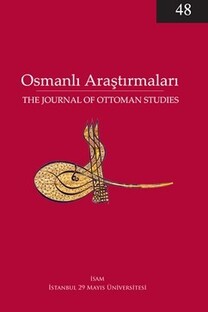Resurrecting Homo Ottomanicus: The Constants and Variables of Ottoman Identity
"Osmanlı kimdir" sorusuna hâlihazırda birçok ilginç cevap verilmiş olsa da, söz konusu cevaplar, çoğunlukla Osmanlı toplumunun renkli doğasını yansıtmakla yetinmekte ve dolayısıyla aslında soyut bir kavram olan Osmanlı kimliği mefhumunu anlamamızı zorlaştırmaktadır. Bu makalede özcü yaklaşımlardan sakınılarak homo ottomanicus'u elle tutulur bir şekilde tanımlayabilmemize yarayacak somut kıstaslar tespit edilmeye çalışılmıştır. Öncelikle Osmanlı toplumu, birbirinden çeşitli sınırlarla ayrılmış fertlerin ayrı ayrı bir öğesini teşkil ettiği bir matris gibi düşünülmüştür. Daha sonra, seçilmiş bir vakanın teşrih edilmesinden yola çıkılarak, imparatorluk tebaasından herhangi bir ferdin kimliğinin, söz konusu matriste işgal ettiği yere göre şekillendiği önerilmiştir. Bunun yanında, söz konusu sınırlardan sadece mali ve hukuki olanların daha katı ve nispeten daha fazla somutlaştırılabildiği önerilmektedir.
Homo Ottomanicus'u Yeniden Canlandırmak: Osmanlı Kimliğinin Sabitleri ve Değişkenleri
The question of "who is an Ottoman" has already yielded interesting answers, but they principally seem to reflect the multifaceted nature of the Ottoman Empire itself and therefore do not bring us much closer to an understanding of the abstract concept of Ottoman identity. While trying not to be essentialist, this article aims to establish some concrete criteria for our definition of homo ottomanicus. The anatomization of one individual case suggests that Ottoman identity was the product of a societal grid composed of a multitude of boundaries, only the fiscal and legal ones of which tended to be rigid and relatively objectifiable.
___
Archival Documents:BOA, Ecnebi Defteri (A.DVN.DVE) 22/1; 51.
Dutch National Archives, ?e Hague: Legation Archives Turkey, File 1266.
The [English] National Archives, London: State Papers 110/70; 110/74 (IV).
Published Works
'Abbud al-şalabi, Yusuf Dimitri, Al-Murtad fi ta'rikh şalab wa-Baghdad, Fawwaz Magmud al-Fawwaz (Ed.), Unpublished MA ?esis, University of Damascus 1978.
Aksan, Virginia: "?e Question of Writing Pre-modern Biographies of the Middle East", Mary Ann Fay (ed.), Auto/Biography and the Construction of Identity and Community in the Middle East, New York: Palgrave Macmillan 2001, p. 191-200.
Anastassiadou, Meropi and Bernard Heyberger (Eds.): Figures anonymes, figures d'élite: Pour une anatomie de l'Homo ottomanicus, Istanbul : ISIS 1999.
Boogert, M.H. van den: "Ottoman Greek in the Dutch Levant Trade: Collective Strategy and Individual Practice (c. 1750-1821)", Ebru Boyar and Kate Fleet (Eds.), ?e Ottomans and Trade, Rome: Istituto per l'Oriente 2006, p. 129-147.
Constantini, Vera: "Venetian Trade and the Boundaries of Legality in Early Modern Ottoman Cyprus", in Suraiya Faroqhi and Gilles Veinstein (Eds.), Merchants in the Ottoman Empire, Louvain: Peeters 2008, p. 35-46.
Kramers, J.H.: Strafrechtspraak over Nederlanders in Turkije, Amsterdam 1915.
Nanninga, J.G.: Bronnen tot de Geschiedenis van den Levantschen Handel. Vierde deel: 1765-1826. Eerste stuk, ?e Hague 1964.
Olnon, Merlijn: 'Towards Classifying Avanias: A Study of Two Cases involving the English and Dutch Nations in Seventeenth-Century Izmir', in Alastair Hamilton, Alexander H. de Groot and Maurits H. van den Boogert (Eds.), Friends and Rivals in the East. Studies in Anglo-Dutch Relations in the Levant from the Seventeenth to the Early Nineteenth Century, Leiden: Brill 2000, p. 159-186.
Schutte, Otto, Repertorium der Nederlandse vertegenwoordigers, residerende in het buiten- land, 1584-1810, ?e Hague: Martinus Nijhoff 1976.
- ISSN: 0255-0636
- Yayın Aralığı: Yılda 3 Sayı
- Başlangıç: 1980
- Yayıncı: TDV İslâm Araştırmaları Merkezi
Sayıdaki Diğer Makaleler
İlk Mehmetçikler Kimlerdi?: Osmanlı Ordusunun Neferleri, 1826-1853
Local intermediaries and insular space in late-18th century Ottoman Cyprus
How to be(come) an Ottoman at the End of the Eighteenth Century
Hattat İsmail Zihni Pasha: Life and Death of an Ottoman Statesman and an Inventor
The Self-Fashioning of an Ottoman Urban Notable: Ahmad Efendi Tahazâde (d. 1773)
